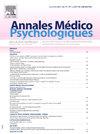La catatonie progressive par accès périodiques ou « catatonie périodique » de Karl Leonhard 2e partie. Diagnostic probabiliste par Bayes-CPAP, opérationnalisation et preuve de concept
IF 0.5
4区 医学
Q4 PSYCHIATRY
引用次数: 0
Abstract
In this second part of the study, we propose an implementation of Karl Leonhard's phenotype of periodic catatonia for ICD-10/11-trained psychiatrists. If the goal is to identify the same subgroup of patients within the schizophrenia spectrum disorders (SSD), we will refer to it as “progressive periodic catatonia” or PPC to emphasize the difference with the classical diagnostic procedure which only makes sense in the context of systems neuropsychiatry. This attempt differs from the previous ones in that we use criteria accessible to practitioners trained in ICD-10/11 and by the replacement of the Boolean polythetic logic by a more integrative Bayesian logic. The principle is simple and consists of using the characteristics whose probability of occurrence is conditioned by the PPC vs non-PPC diagnosis (nPPC). If neither of them is discriminating in isolation, the combination of their likelihood ratios allows us, from a determined prevalence of PPC, to estimate an a posteriori probability of diagnosis. The procedure, named “Bayes-PPC”, requires the evaluation of nine criteria: two concern the evolutionary course, six the residual syndrome (two psychomotor distortions, two negative symptoms, and the absence of two positive symptoms), and the family aggregation. A feasibility study was conducted on 38 PPC and 21 nPPC individuals. Starting from the SSD populations or restricting to SSD with deficit schizophrenia (80% of the population), Bayes-PPC allows for a correct classification of 69 and 67% of the patients respectively. For a posteriori probability higher than 95%, the sensitivity for PPC is 82 and 77% respectively, and the specificity is 100% in all cases. For a posteriori probability less than 5%, the sensitivity for nPPC is 48 and 47% respectively and the specificity is 100% in both cases. These results are encouraging and must now be confirmed in a study involving a larger population and by researchers not trained in the neuropsychiatric diagnostic procedure. They nevertheless suggest the possibility of allowing these same untrained psychiatrists to study the PPC phenotype.
卡尔·莱昂哈德(Karl Leonhard)的《通过周期性访问的渐进式Catatonia》第二部分。贝叶斯-CPAP概率诊断、操作和概念证明
在本研究的第二部分,我们建议对icd -10/11培训的精神病学家实施卡尔·莱昂哈德的周期性紧张症表型。如果目标是在精神分裂症谱系障碍(SSD)中识别同一亚组患者,我们将其称为“进行性周期性紧张症”或PPC,以强调与仅在系统神经精神病学背景下有意义的经典诊断程序的区别。这次尝试与之前的尝试不同,因为我们使用了ICD-10/11培训过的从业人员可以访问的标准,并且用更综合的贝叶斯逻辑取代了布尔综合逻辑。原理很简单,包括使用由PPC与非PPC诊断(nPPC)决定其发生概率的特征。如果它们都不能单独区分,那么结合它们的似然比可以让我们根据确定的PPC患病率来估计诊断的后验概率。该程序被命名为“贝叶斯- ppc”,需要评估九项标准:两项涉及进化过程,六项涉及残留综合征(两项精神运动扭曲,两项阴性症状,两项阳性症状缺失),以及家庭聚集性。对38名PPC和21名nPPC个体进行了可行性研究。贝叶斯- ppc从SSD人群开始或仅限于伴有缺乏性精神分裂症的SSD人群(占人群的80%),分别对69%和67%的患者进行了正确的分类。后验概率大于95%时,PPC的敏感性分别为82%和77%,所有病例的特异性均为100%。在后验概率小于5%的情况下,nPPC的敏感性分别为48%和47%,特异性均为100%。这些结果令人鼓舞,现在必须在一项涉及更大人群的研究中得到证实,而且研究人员没有接受过神经精神诊断程序的培训。然而,他们建议允许这些未经训练的精神科医生研究PPC表型的可能性。
本文章由计算机程序翻译,如有差异,请以英文原文为准。
求助全文
约1分钟内获得全文
求助全文
来源期刊

Annales medico-psychologiques
医学-精神病学
CiteScore
1.30
自引率
33.30%
发文量
196
审稿时长
4-8 weeks
期刊介绍:
The Annales Médico-Psychologiques is a peer-reviewed medical journal covering the field of psychiatry. Articles are published in French or in English. The journal was established in 1843 and is published by Elsevier on behalf of the Société Médico-Psychologique.
The journal publishes 10 times a year original articles covering biological, genetic, psychological, forensic and cultural issues relevant to the diagnosis and treatment of mental illness, as well as peer reviewed articles that have been presented and discussed during meetings of the Société Médico-Psychologique.To report on the major currents of thought of contemporary psychiatry, and to publish clinical and biological research of international standard, these are the aims of the Annales Médico-Psychologiques.
 求助内容:
求助内容: 应助结果提醒方式:
应助结果提醒方式:


